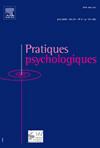Prototypicalité et évocations hiérarchisées : les personnes transgenres constituent-elles une catégorie homogène avec des membres interchangeables ?
IF 0.6
4区 心理学
Q4 PSYCHOLOGY
引用次数: 0
Abstract
Introduction
To understand transphobia, it is necessary to clarify the ambiguity raised by the assignment to categories and the homogeneous/interchangeable aspect of transgender, non-binary, androgynous and genderfluid people. We want to provide accuracies with the prototypical theory and by a language approach.
Objective
The aim of the present research is to determine whether those different persons belong to a homogeneous whole or to several categories with interchangeable (or not) members.
Method
Five hundred forty-two responses have been collected using the method of hierarchical evocations. We randomly presented to respondents a stimulus word (transgender, non-binary, androgynous or genderfluid). Then, participants had to give the first five words occurred to them following the presentation of the stimulus and to classify these words induced from the most to least important to the stimulus.
Results
Several analyses were carried out and showed that semantic categories of induced words were more or less similar between the stimuli (whole or not of categories). Next, we studied the types of word (adjectives, nouns, and verbs) which were different between the stimuli (inclusion level of categories and homogeneity). Finally, prototypical analyses showed induced words with a high frequency and rank of importance more or less similar between stimuli (interchangeability).
Conclusion
Transgender, non-binary, androgynous and genderfluid people seem to be perceived as belonging to a non-homogeneous whole, with more or less interchangeable members.
原型和等级唤起:跨性别者构成一个具有可互换成员的同质类别吗?
为了理解跨性别恐惧症,有必要澄清由对跨性别者、非二元、雌雄同体和性别流动者的分类和同质/可互换方面的分配所引起的模糊性。我们希望通过原型理论和语言方法提供准确性。目的本研究的目的是确定这些不同的人是属于一个同质的整体,还是属于几个具有可互换(或不)成员的类别。方法采用分层唤起法收集了542份问卷。我们随机向受访者呈现一个刺激词(跨性别、非二元、雌雄同体或性别流动)。然后,参与者必须说出在刺激出现后他们想到的前五个单词,并将这些单词按对刺激最重要到最不重要的顺序分类。结果实验结果表明,不同刺激物诱导词的语义类别(全部或非全部类别)基本相似。其次,我们研究了不同刺激物的词类型(形容词、名词和动词)的差异(类别的包含水平和同质性)。最后,原型分析表明,高频率和重要性等级的诱导词在刺激之间或多或少相似(互换性)。结论跨性别者、非二元者、雌雄同体者和性别流体者似乎被视为属于一个非同质的整体,其成员或多或少是可互换的。
本文章由计算机程序翻译,如有差异,请以英文原文为准。
求助全文
约1分钟内获得全文
求助全文
来源期刊

Pratiques Psychologiques
PSYCHOLOGY-
CiteScore
1.40
自引率
0.00%
发文量
19
审稿时长
81 days
期刊介绍:
Pratiques psychologiques is an official publication of the ''Société française de psychologie''.
It publishes thematic issues, and concentrates on the applications in the psychological practice. It covers all fields of psychology.
 求助内容:
求助内容: 应助结果提醒方式:
应助结果提醒方式:


